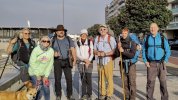- Time of past OR future Camino
- .
OK, so as someone who has a walked a few caminos already, some that tested me physically and mentally, I’ve tended to write off the Portuguese coastal as something of a camino lite for the Instagrammers.
But I found a two week window in dreary UK February and decided to take a punt on it. I invited a compadre I met on the Frances in 2022 and also someone I got to know through this forum but had never actually met.
I guess my preconception was that it would likely be pretty miserable weather and there’d be few, if any, other pilgrims, so it’d be fun to bring some good company along. The reality was quite different and, like the optimal option on an evaluation questionnaire, it’s fair to say that it ‘far exceeded my expectations’!
Grim weather? Nope. I’d been tracking it for 2 weeks before I departed and saw it hold at 18/19C in Porto. Then it started to fall off after we arrived. A couple of nice sunny days by the exhilarating Atlantic surf before a one-day fierce storm – making the Atlantic slightly terrifying. Fortunately the wind at that point was from the south and blew us along the route. The following day’s rain was really hard, but thereafter the days became less showery and by the end we were back in warm dry sunshine again.
Absence of pilgrims? Nope. The first night in Vilar do Conde there were nine or ten I think, and that was actually the average for the whole trip. The most was at Redondela in the Xunta albergue where I counted 17.
Pilgrims were Instagrammers? Nope there was an interesting cross-section of people, predominantly first-timers and Germans and on the younger side, but everyone ‘got it’ and entered into the pilgrim spirit. The enthusiasm was infectious.
Coastal doesn’t feel like a ‘real’ camino? Nope. There are far more trappings of a camino than say the Norte. Lots of church doors left open, lots of welcoming signs and symbols and a few memorials along the way such as mounds of painted stones, prayers and poems and faded pics of not-forgotten friends and relatives. Camino magic examples:– Lynne, formerly of New Mexico, waiting, with her cute dog, for pilgrims arriving at the beachfront at Povoa and greeting them with the gift of a silver scallop shell. The bar owner at Fao who sat at our table while we ate, and yellow-painted blue stones with the scallop shell, one for each of us. The terrifying Atlantic breakers crashing against the sea wall at Oia while us pilgrims ran the gauntlet of a soaking, under the huge forbidding stone walls of the monasterio. The cart grooves in the old track over the hill towards Baiona. The succession of playas from Sabaris along the Litoral, where the surf sounded different at each one. Joining the locals in the Sunday morning queue at the Panaderia/Pastelaria for just-baked heaven. Getting swept up in the Festival of the Pirates in Pontevedra (and no sleep). I could go on.
What’s to like? Enough pilgrims to make it interesting and social, but still always get a lower bunk and not have to ever queue for shower or toilet. Very friendly and enthusiastic local people along the way in both Portugal and Galicia. Good private albergue provision - booking wasn’t necessary (which gave us flexibility to decide on the day/afternoon) but we checked a couple of times that somewhere was open (Gronze about 75% accurate) and one place that was closed helpfully suggested another place 2km along the coast. Albergues all in good order and good food options (NB coastal empanadas are ten times better than those found inland!).
What’s less to like? Until you join the central way, and apart from the coastal boardwalk, it’s about 90% walking on road, pavement or cobbles. The route from Vilar to Povoa down narrow streets with cars required some concentration. But basically you just have to get the cushionest shoes you can find and you will be fine. Private albergue owners tend to be (nice) business people rather than ones who have walked the camino and want to give back. So it’s slightly more of a business transaction, but all the owners/hospitaleras were enthusiastic and helpful. In Pontevedra, hospi Sonia took us all for an amazing hour’s guided tour of the old town, of which she is rightly proud. Caminha provided the best opportunity for making a big communal meal, with a great kitchen and nearby supermarket – and we made the most of it.
By Pontevedra our loose ‘family’ had grown to eleven (ages 13-70). Some of us went left onto the spiritual variant and some of us straight ahead. Both groups had wonderful but very different experiences, which were able to share later in Santiago. And in that city… it has such a different feel when there are far fewer pilgrims about. It felt like more locals were out and going about their business and all the more relaxed for it.
Wrapping up I’d say – I didn’t know what to expect when setting out with invited friends from the start. But actually this camino was perfect for that. We picked up quite a few others along the way, and the final one in the WhatsApp group should reach Finisterre today. I’d definitely plan it with others again and I’d definitely go in February again. In fact, on my current high I imagine making it an annual thing! So much more to explore, including the other path after Pontevedra. And Vigo, why does no-one ever talk about wonderful Vigo?
But I found a two week window in dreary UK February and decided to take a punt on it. I invited a compadre I met on the Frances in 2022 and also someone I got to know through this forum but had never actually met.
I guess my preconception was that it would likely be pretty miserable weather and there’d be few, if any, other pilgrims, so it’d be fun to bring some good company along. The reality was quite different and, like the optimal option on an evaluation questionnaire, it’s fair to say that it ‘far exceeded my expectations’!
Grim weather? Nope. I’d been tracking it for 2 weeks before I departed and saw it hold at 18/19C in Porto. Then it started to fall off after we arrived. A couple of nice sunny days by the exhilarating Atlantic surf before a one-day fierce storm – making the Atlantic slightly terrifying. Fortunately the wind at that point was from the south and blew us along the route. The following day’s rain was really hard, but thereafter the days became less showery and by the end we were back in warm dry sunshine again.
Absence of pilgrims? Nope. The first night in Vilar do Conde there were nine or ten I think, and that was actually the average for the whole trip. The most was at Redondela in the Xunta albergue where I counted 17.
Pilgrims were Instagrammers? Nope there was an interesting cross-section of people, predominantly first-timers and Germans and on the younger side, but everyone ‘got it’ and entered into the pilgrim spirit. The enthusiasm was infectious.
Coastal doesn’t feel like a ‘real’ camino? Nope. There are far more trappings of a camino than say the Norte. Lots of church doors left open, lots of welcoming signs and symbols and a few memorials along the way such as mounds of painted stones, prayers and poems and faded pics of not-forgotten friends and relatives. Camino magic examples:– Lynne, formerly of New Mexico, waiting, with her cute dog, for pilgrims arriving at the beachfront at Povoa and greeting them with the gift of a silver scallop shell. The bar owner at Fao who sat at our table while we ate, and yellow-painted blue stones with the scallop shell, one for each of us. The terrifying Atlantic breakers crashing against the sea wall at Oia while us pilgrims ran the gauntlet of a soaking, under the huge forbidding stone walls of the monasterio. The cart grooves in the old track over the hill towards Baiona. The succession of playas from Sabaris along the Litoral, where the surf sounded different at each one. Joining the locals in the Sunday morning queue at the Panaderia/Pastelaria for just-baked heaven. Getting swept up in the Festival of the Pirates in Pontevedra (and no sleep). I could go on.
What’s to like? Enough pilgrims to make it interesting and social, but still always get a lower bunk and not have to ever queue for shower or toilet. Very friendly and enthusiastic local people along the way in both Portugal and Galicia. Good private albergue provision - booking wasn’t necessary (which gave us flexibility to decide on the day/afternoon) but we checked a couple of times that somewhere was open (Gronze about 75% accurate) and one place that was closed helpfully suggested another place 2km along the coast. Albergues all in good order and good food options (NB coastal empanadas are ten times better than those found inland!).
What’s less to like? Until you join the central way, and apart from the coastal boardwalk, it’s about 90% walking on road, pavement or cobbles. The route from Vilar to Povoa down narrow streets with cars required some concentration. But basically you just have to get the cushionest shoes you can find and you will be fine. Private albergue owners tend to be (nice) business people rather than ones who have walked the camino and want to give back. So it’s slightly more of a business transaction, but all the owners/hospitaleras were enthusiastic and helpful. In Pontevedra, hospi Sonia took us all for an amazing hour’s guided tour of the old town, of which she is rightly proud. Caminha provided the best opportunity for making a big communal meal, with a great kitchen and nearby supermarket – and we made the most of it.
By Pontevedra our loose ‘family’ had grown to eleven (ages 13-70). Some of us went left onto the spiritual variant and some of us straight ahead. Both groups had wonderful but very different experiences, which were able to share later in Santiago. And in that city… it has such a different feel when there are far fewer pilgrims about. It felt like more locals were out and going about their business and all the more relaxed for it.
Wrapping up I’d say – I didn’t know what to expect when setting out with invited friends from the start. But actually this camino was perfect for that. We picked up quite a few others along the way, and the final one in the WhatsApp group should reach Finisterre today. I’d definitely plan it with others again and I’d definitely go in February again. In fact, on my current high I imagine making it an annual thing! So much more to explore, including the other path after Pontevedra. And Vigo, why does no-one ever talk about wonderful Vigo?
Last edited:




















